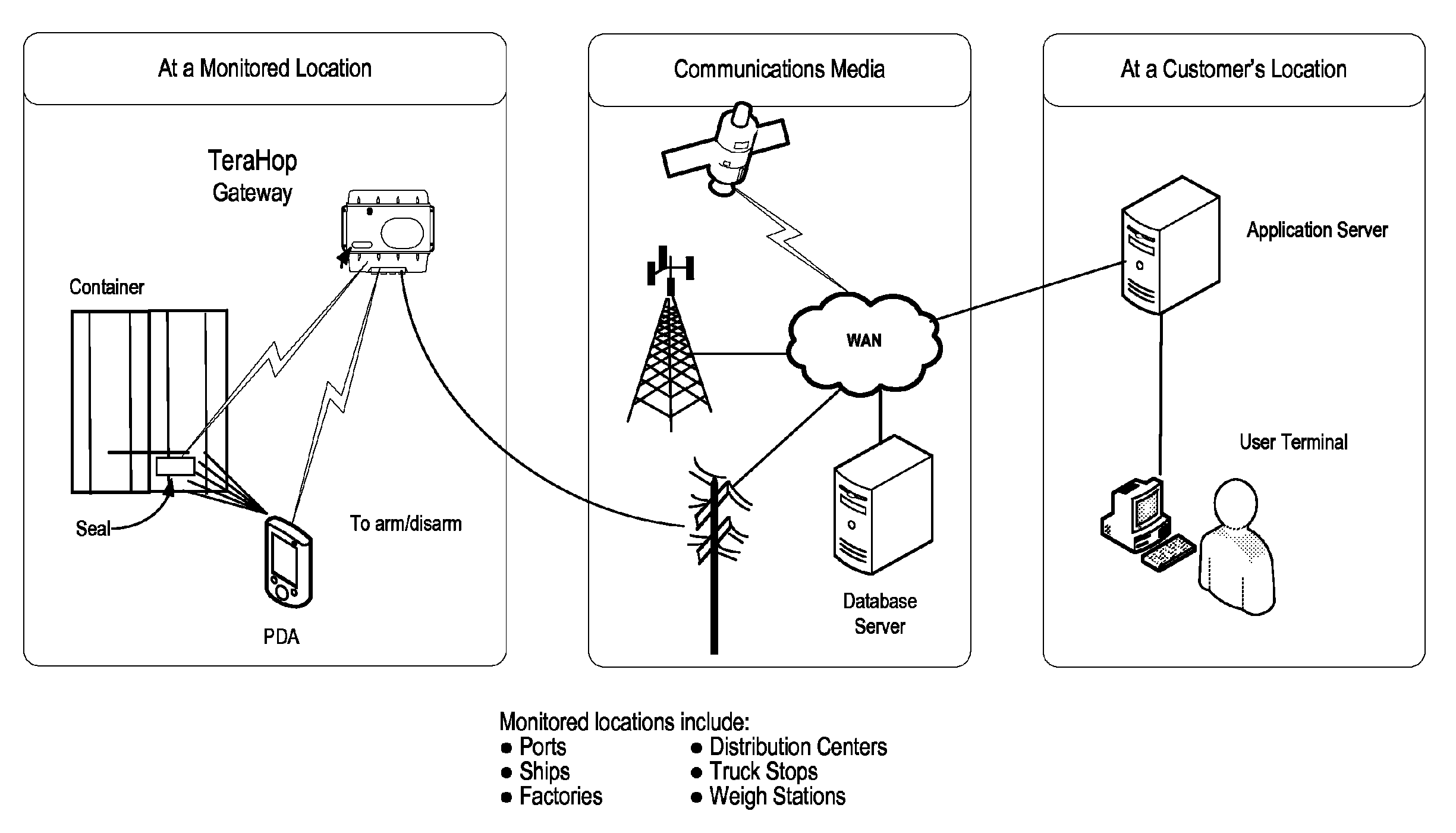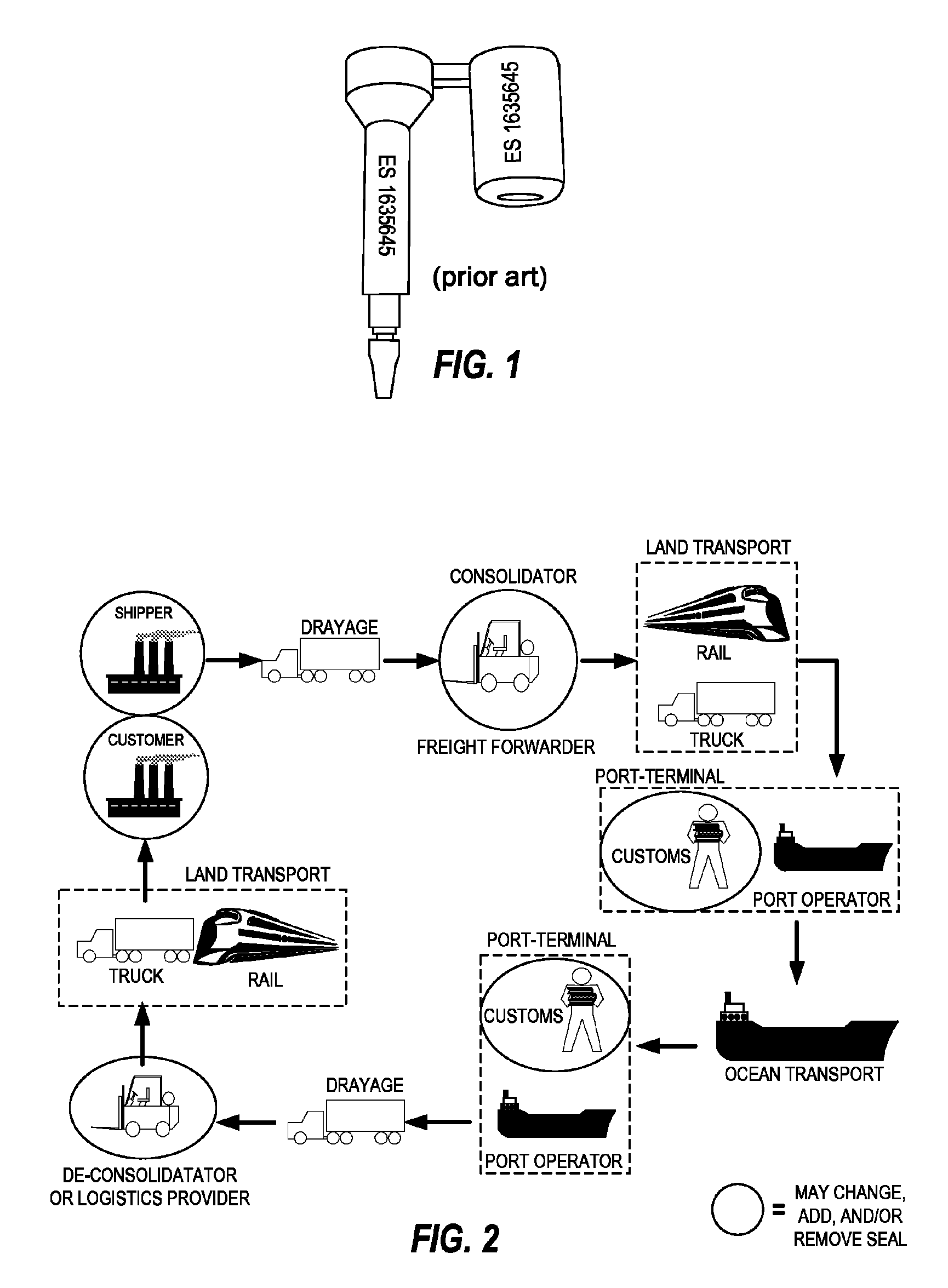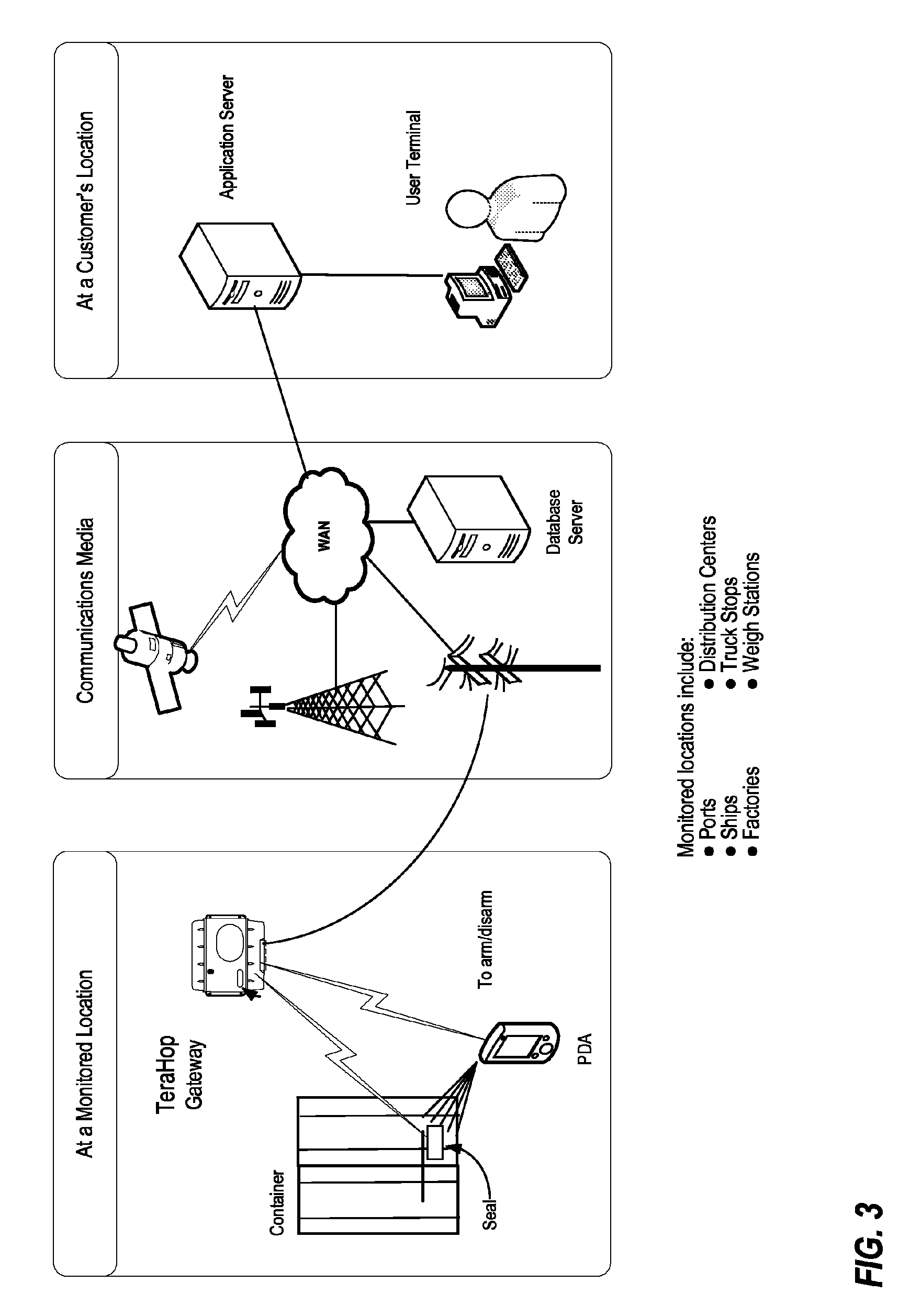Although the use of containers had immediate potential for greatly increasing port and shipping efficiencies, the high infrastructure cost for port facilities, e.g., cranes, made initial adoption slow.
Each one has the potential for loss and for concealing smuggling, including smuggling of weapons of
mass destruction (WMDs).
There is some variability of the location of strengthening ribs of the
doors versus the locking handles, which may affect seal positioning.
However, for the overwhelming number of shipments, containers are around only when actually loading or unloading goods.
There is no handling of the container at such stops, unless unauthorized.
These stacks are usually up to five containers high, with one-to-two foot spaces in-between stacks, which minimally allows for
yard equipment and people to move among the rows / aisles for later retrieval.
Having containers piled up in a port too far in advance of a ship's arrival causes congestion.
If they arrive too early, they may be turned away.
If they fail to pick up within their window, they may be charged a demurrage fee.
If a shipper, Customs, or other authorized player in a given shipment discovers a broken seal, then it is likely that the container has been opened improperly, and goods have been taken or added.
Mechanical container seals are better than no seals; however, even when numbered seals are mated to matched housings, there is often no end-to-end
record of seal serial numbers as they are changed in the normal course of a given end-to-end shipment.
Mechanical seals have no memory, nor do they have any kind of reporting capability.
Consequently, no one but the criminals themselves know that something improper has occurred until the container fails to arrive at its intended destination, or until it arrives and the contents are not what are expected.
Some thieves simply bring in a
tractor to take the entire container away and remove the contents later at a concealed location, while others coerce or bribe the
tractor driver and steal the entire rig.
Mechanical seals also have no radio-reporting nor locating capability.
Of course, if a container is high on or deep within a stack, reading of the e-seal can be problematic.
Additionally, e-seals also have no motion-sensing capability.
They have no capability to detect or report unauthorized movement or mechanical disturbance.
Furthermore, e-seals are used in RFID-based systems that are limited in detecting and reporting presence of the e-seal and respective container to which it is attached.
The e-seals must either periodically broadcast their presence, thereby consuming battery power and diminishing the useful life of the e-seal, or wait to be interrogated as to whether they are still present, which requires extensive infrastructure and opens
time windows during which losses can occur.
Moreover, e-seals also generally have no hopping capabilities.
Consequently, the amount of infrastructure required to cover an entire port,
yard, ship, or
train can be very extensive; coverage can therefore be spotty; and / or readers must be located at
choke points, which can slow traffic considerable.
For mobile applications (e.g., ships and trains), effective infrastructure may be unworkable.
The cost of the infrastructure required for even this capability appears to be prohibitive for most yards and ports to justify, and out of question for other public sites such as weigh stations and
truck stops.
Operational life and efficiency can also be negatively impacted, especially in areas of high traffic RF transmissions.
Indeed,
confusion often results when a multitude of e-seals are in close proximity and attempt to transmit over each other.
Needless to say, battery life can also be limited, especially for single-use, disposable e-seals.
It will thus be appreciated that systems utilizing RFID technology in such e-seals are limited by poor
scalability, poor
wireless security,
RF noise and interference, lack of real-time alerting, and high infrastructure requirements.
However, in addition to most of the limitations cited above for RFID, RTLS is additionally limited by extensive / expensive infrastructure that is required to achieve useful precision across a large area.
If the device is offset far towards one side, precision diminishes rapidly.
Also, the effectiveness of RTLS technology is affected by changes in RF propagation, and the movement and storage of large numbers of containers at yards and ports can change RF propagation significantly.
Due to the limitations of RTLS technology, its use in cargo and
shipping container implementations is usually limited to
yard management, for which RTLS technology is used to pinpoint the location of containers, to possibly enable faster retrieval of staged containers, and to improve yard / port
throughput.
The time interval and the resolution of the associated mapping application make it unlikely that there could be timely intervention to thwart a theft.
Additionally, no mechanical disturbance detection or reporting is provided, and no seal breach detection or reporting is provided.
GPS technology also enables very limited presence detection.
A container could easily be stolen if the timing and interval of the GPS readings were off, unless GPS updates and reports were frequent.
However, frequent reporting is usually very expensive.
GPS technology also works poorly, if at all, when containers are stacked, as GPS devices must have
visibility to a large portion of the
sky.
Thus, systems utilizing GPS really are no more ideal, as GPS requires line-of-
sight reception from multiple satellites, which limits
system utility with assets that are located indoors or in other obscured sites.
It will be appreciated that systems utilizing GPS are limited by its high consumption of battery power, high device costs, high operating costs, and need for a separate data communications link to report asset position and / or to report sensor data.
On the other hand, the use of e-seals has not been widely or rapidly adopted.
The principal objections appear to be the cost of infrastructure (which the ports are unwilling to bear), cost of the devices ($10s each), lack of a complete standard, and lack of a government mandate.
Although the cost may initially be borne by ports and yards, the cost is eventually borne by shippers.
So far, the US government has been the global driver for a solution but has been slow to define requirements, apparently not wishing to disrupt commerce or irritate commercial interests with a solution that is focused overwhelmingly on security.
For instance, the U.S. government has implemented the Customs-Trade Partnership Against Terrorism (C-TPAT) program and while compliance with C-TPAT is not mandatory, those shippers that do not comply may encounter added delays when passing through customs checkpoints.
Unfortunately, the RDI technology requires that the container pass close by a reader or that a reader be brought close to the CSD device for the historical data to be read from the RFID technology of the CSD.
Neither (so far) considers the needs of commercial interests, nor the burdens that these security-driven systems may put on those interests.
Needless to say, the integrity of
cargo container seals affects both commercial interests (businesses) and national security (government).
Checking whether things having been added requires some level of inspections, which costs time.
So, the concerns of commercial interest and government are sometimes at
odds.
In particular, it is believed that the Solution addresses the following problems related to the security and efficiency of using shipping containers:Mechanical seals are easily circumvented, tampered with, or substituted with counterfeit seals.When mechanical seals are circumvented, tampered with, or substituted: the event often occurs at a time and place that makes detection and
recovery unlikely (e.g., at night when no one is around to observe or react to the event), the method foils timely detection (e.g., the latch hinge pin is removed and replaced), there is no date / time / location
record associated with the tampering, making claims for loss and damages problematic.Checking mechanical seals visually / manually adds time and is prone to error.Re-checking containers because seal integrity is suspect adds time.
Current practice does not provide for seal serial number integrity as a container moves through the supply chain for any given transit.Visual / manual and common electronic methods for detecting and recording the arrival and departure of containers are unreliable in detecting and reporting the continued presence of a container.
Consequently, in a busy or congested yard, one cannot be sure that a given container is still in the yard, and one may not be alerted that a checked-in container is missing.Drivers are often (some say, nearly always) complicit in unauthorized-opening events (theft or addition).Paperwork associated with shipments (primarily manifests) move separately from the shipments, which can cause
throughput delays.
The impediments add little added cost to either commercial or government operations, but significantly increase the risks and costs for thieves and others to act.Automatically receive timely and accurate information regarding the location of containers and determine when, and in some cases where, container seals were installed and removed.Automatically receive alerts when a container at monitored locations is being disturbed or moved at times when there should be no disturbance or movement (e.g., after normal
business hours), and have that alert provided soon enough either to interrupt the event or to recover the container before serious loss or contents tampering.Automatically receive alerts when a checked-in container is no longer present, and have that alert soon enough that a search has much higher likelihood of
recovery than by current means.Have an accurate, sequential, date / time-stamped records of all events, which records are automatically collected and stored.Automatically receive “over-the-
horizon” (i.e., “blue-water”) notifications of anomalies.Have both mechanical and electronic features to protect shipments from unauthorized activity, wherein the structural features will be familiar to users of the container seals and will work regardless of enablement of the electronic features
They will likely never remove, or replace a seal.
Additionally, it is believed that steamship companies may be likely buyers of infrastructure and may be providers of infrastructure services on their ships, but they will likely not use the infrastructure.
In contract, it is believed that steamship companies will likely not install, remove or replace a seal, nor even be aware of an alarm initiated by a seal.
Similar to steamship companies, these parties will likely never install, remove, or replace a seal.
They also will likely never install, remove, or replace a seal (unless they are also engaged in other functions, such as consolidation); however, their logistics staff will likely desire to track shipments and seal status and will likely respond to alarms.
If used in a closed-loop
system, such parties also will likely have to manage seals for reuse.
If used in a closed-loop
system, buyers also will likely have to manage seals for reuse.
Insurance companies are neither buyers nor users of either seals or infrastructure; however, they will desire to minimize losses from claims by their insureds.
 Login to View More
Login to View More  Login to View More
Login to View More 


